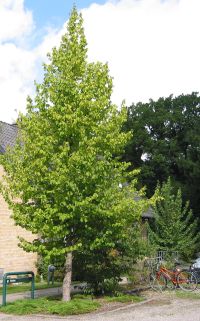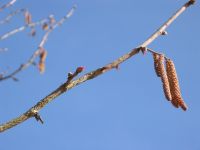Turkish hazel, Turkish filbert - Corylus colurna
English name:
Turkish hazel, Turkish filbert
Scientific name:
Corylus colurna
Family:
Betulaceae (Birch)
Height:
up to 20 m.
Flowering:
Mid March
Range:
SE Europe to N Iran
 |
 |
 |
The 25 year-old, 8.5 m tall Corylus colurna in the pictures comes from seed collected in Macea, Arad County, Romania by the Botanical Garden of the University of Lasi,. This tree was transplanted about 10 years ago to its present position on the edge of the Arboretum parking lot: square 1017 position 3102.
Plant description:
Here is a tree that is described as being too little known and too little grown. It has a formal pyramidal form and dense attractive summer foliage that stays green even when droughty conditions burn the foliage on other trees. It draws attention in early spring with its hanging catkins and attracts squirrels with its nuts in the autumn. Its shallow root system makes it relatively easy to transplant, and tolerates a wide range of soil conditions, wind and air pollution (reported not to be salt tolerant). It is an excellent tree for urban environments. The nuts are reported to taste as good as the common hazelnut.
The genus Corylus is widely distributed in northern temperate forests. The distinguishing feature of the genus is the large nut which when unripe is enclosed in leafy helmet like bract (Corylus means helmet). The male inflorescence (catkin) is formed in the autumn and hangs down in the late winter. Corylus nuts are used directly in cooking and the oil from them is used for paint, soap and for confectionery especially in nut-chocolate mixtures. The genus is reported to have 15 to 18 species. We have 8 species of Corylus growing in Hørsholm, and 5 specimens of Corylus colurna, including one at the Forest Botanic Garden in Charlottenlund.
Corylus colurna is mentioned in Danish garden books as early as 1799. Our oldest living plant is from 1948 and came from the well know nurseryman Aksel Olsen from Kolding. This hazel species can be seen in the catalogues of several Danish nurseries. Older specimens are reported to be found at the park at Frederiksberg Hospital and in Ørstedsparken. It has also been more recently planted as a street tree in the greater Copenhagen area.
Corylus colurna is a deciduous tree up to 20 m in height with a conical crown. The bark is brown and scaly when young and rather attractive in winter. The twigs and petioles are covered in hairs. The leaves are simple, up to 12.5 cm across, with double saw-toothed edges and a heart shaped base. They are shinny green on top. The female flowers are largely hidden but the bright red stigmas peek out in spring and are quite small but showy. The male flowers occur in hanging catkins which can be seen the whole winter and open in March in Denmark. The nuts occur in tight groups, each surrounded by a strongly fringed bract.
References:
Bean, W. J. 1980. Trees and shrubs hardy in the British Isles. Vol. I A-C. John Murray Pubs. Ltd. London. 845 pp.
Govaerts, R. & Frodin, D.G. 1998. World checklist and bibliography of Fagales. Royal Botanic Gardens of Kew. London. 407 pp.
Lange, J. 1994. Kulturplanternes Indførselshistorie i Danmark. (Introduction History of Cultivated Plants in Denmark). Jordbrugsforlaget, Frederiksberg. 458 pp.
Mabberley, D.J. 1998. The Plant Book. The Bath Press, Bath, 858 pp.
Mitchell, A. & Ødum S. 1983. Træer i Nordeuropa. Gads forlag, Copenhagen, pp. 354-355.
Poor, J.M. & Brewster, N.P. 1994. Plants that merit attention. I. Trees. Timber Press Inc. Portland.
Rushforth, K. 1999. Trees of Britain and Europe. Harper Collins Publisher. 1336 Pp.
United States Forest Service. 1993. Tree Fact Sheets: https://hort.ifas.ufl.edu/database/trees/trees_scientific.shtml
